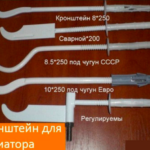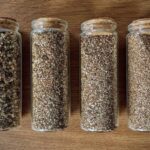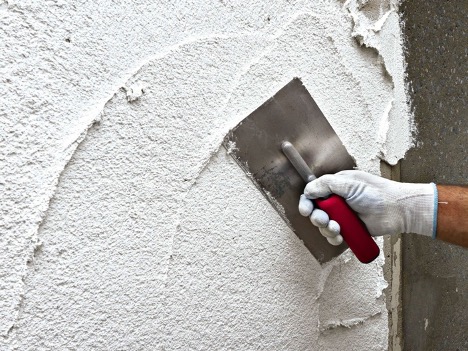Do-it-yourself thermal insulation plaster for external and internal work: what is it?
Thermal insulation plaster is a mixture with porous components (vermiculite, expanded polystyrene) that provide protection from heat and absorb sound. Such compositions are more expensive, but they are durable. The main pros and cons and finishing technology are described below.
The content of the article
Features of heat-insulating plaster
Plaster with thermal insulation properties basically contains the same components as regular plaster. But it also contains porous mixtures that have low thermal conductivity. The material contains many air bubbles, which transmit heat extremely poorly, keeping it indoors. In addition, cavities increase sound insulation, which is especially important for city apartments.
Warm plaster for external use contains the following mixtures as additional components (pictured from left to right):
- expanded clay (small crumbs in the form of granules);
- perlite sand (goes through the swelling stage);
- vermiculite (also expanded).

Thermal insulating plaster for external use may also contain expanded polystyrene or foam glass in the form of granules. They not only retain heat, but also provide sound insulation and high permeability.Despite the fact that the material is artificial, it “breathes” well and thanks to this creates an optimal microclimate in the room.
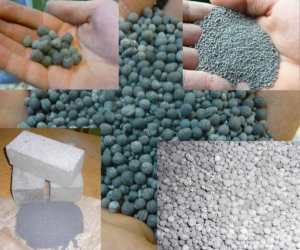
Areas of application and types of material
Insulating plaster is used for different types of work:
- Interior wall finishing to level the surface, increase heat and sound insulation.
- Finishing of facades for similar purposes, as well as for creating a decorative coating.
- “Well masonry” - in this case, you prepare a mixture of warm plaster for the facade with your own hands. The resulting composition is used not for surface treatment, but as insulation. They fill voids directly during the construction of walls.
- Plaster is often used as insulation for interior work. For example, this composition is used to fill door and window openings.
Based on the composition, there are several types of insulated plaster:
- Perlite - it is made from natural volcanic glass. The material is resistant to temperature changes, bacteria, fungi, but can absorb quite a lot of moisture.
- Expanded polystyrene in the form of granules is affordable, retains heat well and provides sound insulation.
- Foam glass is a material of natural origin made from quartz sand. It is well resistant to water, so it can be used for finishing rooms with a humid microclimate. However, the thermal insulation is not the highest.
- Vermiculite insulating plaster for exterior work is often used. The mixture, after hardening, gives a very durable surface that is resistant to fungi and bacteria. But it absorbs moisture well, so it cannot be used for wall decoration, for example, in the bathroom or kitchen.
Pros and cons of warm plaster
The main advantage of this composition compared to the classic one is that it really increases thermal insulation. The mixture can be used at all stages from wall construction to processing after removing old material. Along with this, plaster for insulating walls from the inside has other advantages:
- Simple application - essentially the same as with the regular composition. However, it is worth considering that the layer should be much thicker.
- Plaster for wall insulation provides a continuous coating without seams. Thanks to monolithic processing, it is possible to eliminate “cold bridges” through which a lot of heat is lost.
- The composition is universal, it can be applied to any base - brick, concrete, gas silicate, etc.
- As already mentioned, warm plaster prepared by yourself provides not only heat but also sound insulation.
- Reliability and long service life - at least the same number of years as a conventional composition.
- Warm plaster is resistant not only to temperature changes, but also to bacteria and mold.
But it is worth keeping in mind that such mixtures also have disadvantages:
- High consumption due to the need to apply a thick layer.
- Higher price - compared to conventional compositions, plaster with insulation costs 1.5 times more.
- The composition is not suitable for finishing because it absorbs moisture well. For the same reason, it should not be used in a bathhouse, bathroom, or kitchen.
- Since the layer is thicker, you will need to wait longer until it dries.
- Some types of plasters (polystyrene based) are flammable.
How to apply plaster
Now it’s clear what warm plaster is.All that remains is to figure out how to lay it correctly to ensure maximum wall insulation. The work is carried out in several stages, the sequence is as follows:
- Prepare the mixture according to the instructions, knead using a construction mixer or drill with the appropriate type of attachment.
- Prepare the surface - dismantle the previous coating, and also get rid of all relatively large defects - seams, cracks and others.
- Take a trowel or spatula and begin to apply the composition.
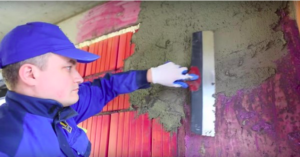
- A fiberglass reinforcing mesh is embedded into it. Its individual layers are overlapped with an intersection of at least 10 cm.

- Moving vertically, add small piles of the mixture at intervals of about 50 cm.
- The profile is slightly recessed into the composition, adjusting its position according to the building level.
- The voids under the lighthouse are filled with plaster.
- The remaining beacons are attached in the same way.
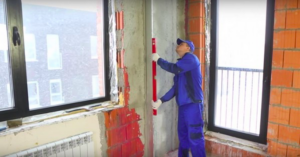
- After the reinforcing layer has set and the beacons are securely in place, pour the mixture to fill the entire space between the profiles. In this case, the composition should protrude more than the level of the beacons.
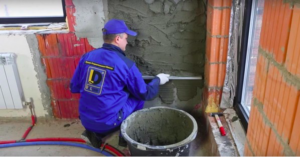
- Continue applying the compound until the surface is smooth. The beacons are removed, and the cracks are also filled with plaster.
At the last stage, finishing is done, for example, laying tiles, a plastic panel or decorative mixture. These materials can be laid even on a rough surface, which avoids puttying.
Thermal insulating plaster involves using a mixture in large quantities to create a dense layer, so the cost of such work will be more expensive than with conventional material. On the other hand, increasing thermal insulation allows you to save on heating costs.

